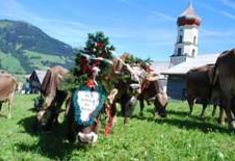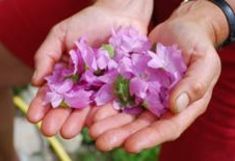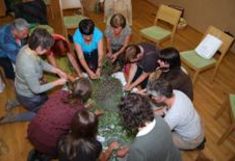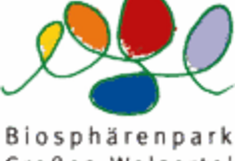Monitoring Biocultural Diverstiy
BioCultural Diversity Monitoring in the Biosphere Reserve Großes Walsertal, Austria
Link between the diversity of wild gathered species, traditionally grown crops and their cultivars to local peoples’s culture, profession and preferences Data about the project in BOKUs Research data Base
Figures: “Alpabtrieb” (going down with livestock from Alpe Laguz), Raggal; Flowers from Malva sylvestris for tea; Women from the Alchemilla-project mixing tea herbs (Fotos: Grasser 2008)
The project
BioCultural Diversity Monitoring – The use and management of biodiversity of crops, cultivars and wild gathered species in the Biosphere Reserve “Großes Walsertal” (Vorarlberg, Austria) A MaB (Man & Biosphere) research project funded by the Austrian Academy of Sciences
Project Final Report (German)
Team: Susanne Grasser, Christoph Schunko, Brigitte Vogl-Lukasser and Christian R. Vogl Working Group for Knowledge Systems and Innovations |
Figure: Logo of the Biosphere Reserve
Publications within the Project
Biosphere Reserves are known for their rich biodiversity. In the scientific discourse about conservation of biodiversity and in conservation efforts, often only the “wild” biodiversity is tackled. The Biosphere Reserve “Großes Walsertal” is known for the highly intensive link of local people with this wild biodiversity, using gathered plant species as medicine for humans and animals, as food, for religious ceremonies and for ornamental purposes. In addition one can find in the Biosphere Reserve home gardens, small arable plots for subsistence and orchards with a high diversity of traditional species and local cultivars. This diversity of wild gathered species, crops and their cultivars is closely linked to local peoples’ culture, profession and preferences. The link of used biodiversity and local culture – as we call it here: the biocultural diversity – has not been studied yet in this Biosphere Reserve by state of the art scientific methods. Nor have been undertaken attempts here to link an inter- and transdiciplinary research process with activities of endogenous development.
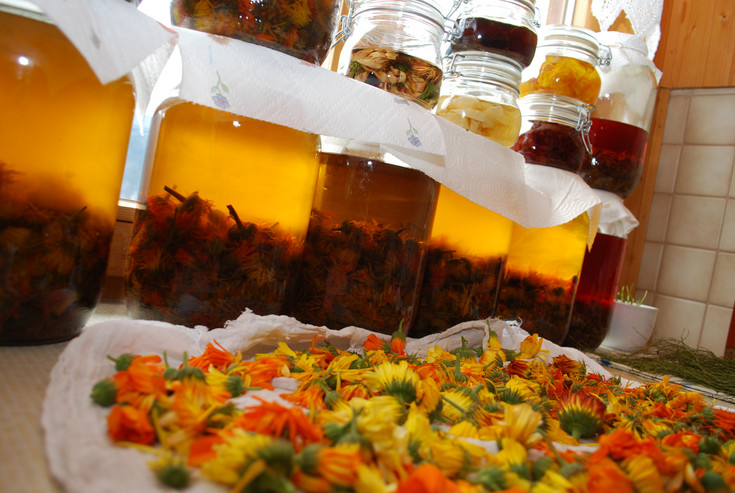
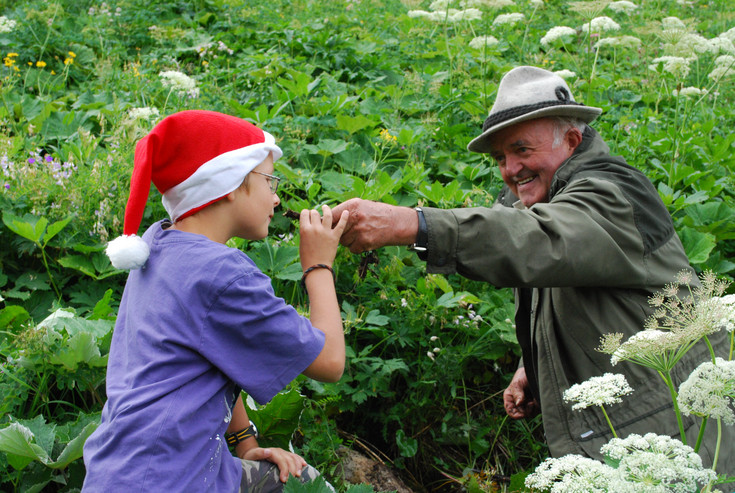
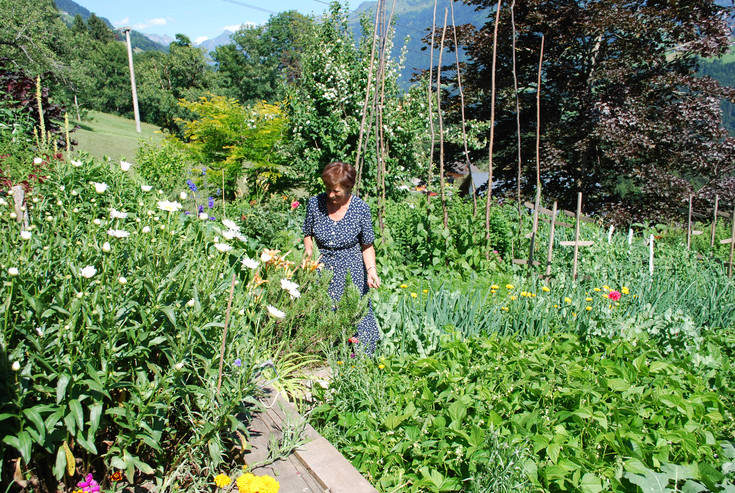
Figures: Calendula officinalis in oil; Knowledge transmission about Peucedanum Ostruthium; homegarden in St. Gerold (from left to right) (Photos: Grasser 2008-2010)
Thus the objectives of this project are:
• to make visible the inextricable link between biological diversity and local knowledge in the Biosphere Reserve
• to improve the sustainable management of the Biosphere Reserve
o by including the diversity of crops, cultivars and wild gathered species into the Biosphere’s management plan
o by including local peoples’ practice, knowledge & social organization of local biodiversity management into the Biosphere’s management plan
• to contribute to the Sevilla Strategy (1996) and to serve as an example for other Biosphere Reserves.
We aim to document in the Biosphere Reserve with state of the art interdisciplinary methods
• the diversity of plant species gathered by local people,
• the diversity of traditional crops and their cultivars grown by local people,
• the diversity of local uses, habits and preferences related to these elements of biodiversity.
The involvement of local actors in planning and management of the Biosphere Reserve is seen to be very important. Although gender is said to be an important aspect in all European policies women’s role in biodiversity conservation and management is mostly neglected. Women do play an important role in biodiversity conservation and have a specific knowledge. Thus, we want to make visible the role of women as users and managers of biodiversity and their distinct forms of attitudes and traditional knowledge.
The research process is linked from the beginning to local actors and initiatives through stakeholder workshops, involvement of local people in data collection and analysis and through participatory assessment and dissemination of results at local level, incl. schools, libraries and art festivals.
Inter- and transdisciplinary? - Science goes public
Working together from different disciplines (interdisciplinary) provides a diverse approach to the world of plants. Combined with social science methods, e.g. through interviews and participatory observation, the connectedness of people and plants can be lighted up (Ethno-Botany).
Through participation of local people in the research process (transdisciplinary) a direct connection between science and practice can be established.



Figures: Children of the primary school in Blons working with a plant puzzle; children from the primary school in Thüringerberg presenting plant pictures; children from the primary school St. Gerold at a plant game (from left to right) (Photos: Grasser 2009)
In spring 2009, children of all primary schools (189) in the Großes Walsertal were sent out with a questionnaire to interview their parents and grandparents about their plant knowledge. A high participation shows people’s interest in the issue of wild plant gathering as well as their willingness to actively take part in this research process.
Two videos, made by children and local people in the valley in the year 2010, illustrate the value and vitality of local people’s ecological knowledge.
Human & herbs in sound & image
May healing with herbs border on witchcraft, to work with camera, light and microphone is not. This is proved by the children from the Großes Walsertal. They wrote scripts about the most exciting stories about herbs, berries and roots. As researcher they interviewed experts on plants in their communities. They filmed collecting and processing of bear’s garlic, spruce sprouts, calendula and many more.



Figures: Children in the participatory video workshop (Photos: Grasser 2010)
With great enthusiasm they slipped into the roles of a director, cameraman, sound-mixer, lighter or script-writer. Together they made an herbal documentary where the most interesting “herb stories” can be shown from a children’s point of view. The films were developed through two participatory video workshops conducted by Maria Weber (film-maker) and Susanne Grasser (Ethnobotanist, BOKU).
The premiere of the films "Kraut im Bild" (Herb news) und "Ein Zwerg kaut am Berg Kraut" (A mountain dwarf chews herbs) was in September 2010 at the cultural festival Walserherbst. The films as well as Backstage can be watched on youtube: Kraut im Bild - Herb news Kraut im Bild 1 (birch leaves and "meadow-salad"), Kraut im Bild 2 (bear's garlic soup), Kraut im Bild 3 (calendula ointment and stinging nettle tea), Kraut im Bild 4 (spruce sprouts syrup), Kraut im Bild 5 (tea herbs), Backstage Ein Zwerg kaut am Berg Kraut - A dwarf chews mountain herbs Ein Zwerg kaut am Berg Kraut 1 (elder cake), Ein Zwerg kaut am Berg Kraut 2 (tea herbs), Ein Zwerg kaut am Berg Kraut 3 (lavender-honey soap), Ein Zwerg kaut am Berg Kraut 4 (flower ointment), Ein Zwerg kaut am Berg Kraut 5 (masterwort), Backstage Flyer to the film (pdf)
Appreciation as basis
Many comments of local people show that knowledge about wild gathered plants and uses is still very vivid in the Großes Walsertal: „…dass die Kräuter, Gräser und Früchte der Natur geschätzt und in Ehren gehalten werden” (translated: that the herbs, grasses and fruits of nature are appreciated and honored)
„…dass auch unsere Kinder lernen, dass es etwas besonderes ist und unser Gott das alles uns gibt” (translated: that our children learn that it is something special what our God is giving us)
This conscious appreciation is the basis for a sustainable use of natural resources.



Figures: Gathering of dandelion (Taraxacum officinale agg.); researcher in the field; dried herbs (from left to right) (Photos: Grasser 2008-2010)
Diploma thesis within the project
Grabowski M. (2010): „Meisterwurz und Aderlass“ Anwendung und Wandel des ethnoveterinärmedizinischen Wissens im Großen Walsertal/Vorarlberg unter Hervorhebung der pflanzlichen Hausmittel und des religiösen Brauchtums. Diplomarbeit. Universität Wien. Vogl T. (2011): Lokale Gemüsesorten. Erfahrungswissen von Hausgärtner_innen zu Lokalsorten im Biosphärenpark Großes Walsertal (Vorarlberg). Masterarbeit. Universität für Bodenkultur. Frank B. (2011): BioCultural Diversity in Europe. A Literature Review of Selected Projects. Diplomarbeit. Universität für Bodenkultur. Diplomarbeit. Universität für Bodenkultur.
Publications within the Project
Poster (EN)

